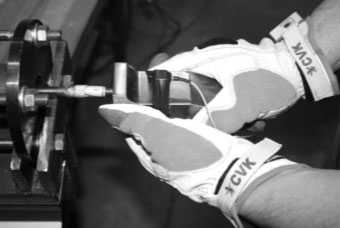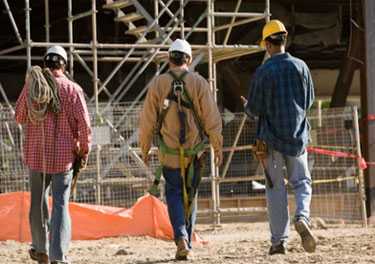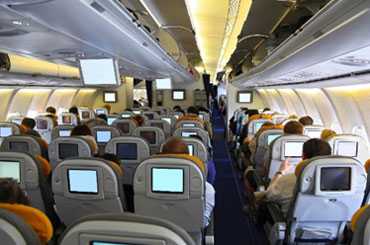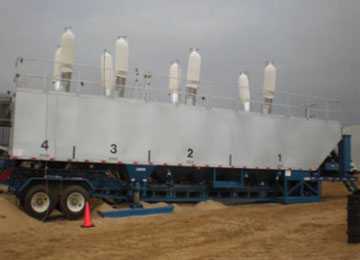NIOSH Research Rounds
NIOSH Research Rounds is a monthly bulletin of selected research at the National Institute for Occupational Safety and Health.
Volume 2, Number 1 (July 2016)
Investigators Design Experimental Engineering Control for Silica Dust
Silicosis is an irreversible, but preventable, occupational lung disease caused by inhalation of respirable crystalline silica dust (RCS). Each year, millions of workers, primarily in construction, sandblasting, and mining, are at risk of silicosis (and lung cancer) from exposure to RCS. National Institute for Occupational Safety and Health (NIOSH) investigators study how to prevent workers’ exposure to this serious health risk. Recently, they developed a novel engineering control, called the NIOSH mini-baghouse retrofit assembly, to help control RCS released from sand moving machinery on oil and gas extraction sites. Below, study lead author Barbara M. Alexander, Ph.D., P.E., C.I.H., NIOSH engineer and industrial hygienist, explains how the experimental tool works.
Q: What is the risk to workers near sand movers?
During the process known as hydraulic fracturing, workers use special equipment that injects fluid under high pressure into a drilled well to break apart the rock formation and release the oil and gas. Typically, the fluid primarily contains water, sand or a similar substance, and treatment chemicals. Using pressurized air to transfer sand from delivery trucks into sand movers generates RCS, which then disperses into the air.
Workers face a significant health risk from inhalation of RCS during hydraulic fracturing and other oil and gas extraction tasks. At hydraulic fracturing sites, NIOSH investigators identified concentrations of respirable silica that were 10 to 50 times over the permissible limits set by the Occupational Safety and Health Administration. NIOSH research has identified at least seven sources of airborne RCS release at oil and gas extraction sites during hydraulic fracturing.
Q: What is the NIOSH mini-baghouse and how does it work?
To protect workers from RCS, engineering controls must be used whenever possible to limit the RCS released. The NIOSH mini-baghouse is a new engineering control that we developed for this purpose. Basically, the NIOSH mini-baghouse is exactly what it sounds like: a smaller version of the large cloth bags used in commercial equipment to trap particles and reduce air pollution. The NIOSH mini-baghouse consists of filter material and ductwork connected to a baseplate that clamps to the openings, called thief hatches, on top of a sand mover. The NIOSH mini-baghouse reduces sand dust emissions coming out of the thief hatches by trapping RCS before it disperses into the air where it would pose a health risk to workers.
The initial design concept incorporates high-efficiency filtration. It exploits energy used to blow the sand into the sand mover, which creates the dust, and so uses no additional power such as a diesel engine. It is a low-cost, bolt-on retrofit for existing machinery, making it ideal for the thousands of machines operating on hydraulic fracturing sites.
We tested the effectiveness of the NIOSH mini-baghouse in the field at an Arkansas sand mine on November 18-21, 2013. During the trial, we collected area air samples at 12 locations on and around a sand mover with and without the NIOSH mini-baghouse control installed. Our results indicate that the NIOSH mini-baghouse effectively reduced both respirable dust and RCS downwind of the thief hatches. The reduction of airborne respirable dust ranged from 85% to 98%, and the reduction in airborne RCS ranged from 79% to 99%. In another significant finding, a sample of dust collected by the NIOSCH mini-baghouse showed the presence of freshly fractured quartz, which is a particularly hazardous form of RCS.
Q: What are the next steps?
Next, we plan to enhance the performance of the NIOSH mini-baghouse with several engineering improvements to the clamping mechanism, filter fabrics, sealing surface, and material measurements. After that, we plan to evaluate the new and improved NIOSH mini baghouse in the field and then commercialize and license the technology to industry.
More information is available:
In This Issue
NIOSH Research Rounds is Brought to You By:
- John Howard, M.D., Director
- Fred Blosser, Editor in Chief
- Anne Blank, Story Editor
- Tanya Headley, Contributing Editor
- Cathy Rotunda, Copy Editor
- Glenn Doyle, Technical Lead
- Mary Micciche, Technical Support
Get Email Updates
Subscribe to the NIOSH Research Rounds Newsletter:
New Laboratory Method Evaluates Vibrations From Hand-held Riveting Tools

Scientists developed an apparatus and a laboratory-based methodology to simulate a riveting task to measure bucking bar vibrations. Photo from NIOSH.
When considering aircraft worker safety, the most visible jobs—pilot, air traffic controller, security screener—often come to mind. In truth, however, worker safety begins long before takeoff. During aircraft construction and maintenance, workers attach layers of sheet metal to airframes using hand-held tools called bucking bars. Used with air-powered riveting hammers, bucking bars enable workers to set rivets into predrilled holes in aircraft and other products. The problem is that bucking bars, like most powered hand tools, transmit vibrations, which increase the risk of injuries and disorders to the blood vessels, nerves, muscles, and bones of the hands. Although manufacturers have introduced new types of bucking bars designed to reduce risk, their effectiveness is unclear because there is no standardized method to measure their transmitted vibrations.
Recognizing this need, scientists at the National Institute for Occupational Safety and Health (NIOSH) recently developed and tested a lab-based riveting simulator that mimics the conditions observed during actual riveting tasks. The riveting simulator delivers reliable and repeatable forces to a bucking bar when measuring vibrations transmitted to the hand. With this new apparatus and laboratory method, NIOSH scientists evaluated three traditional steel rivet bucking bars and six newer bucking bars. Specifically, the newer designs included three bucking bars made from tungsten and three bucking bars with a mechanism designed to decrease vibrations. To compare to typical riveting tasks, the scientists also tested the bucking bars during three such tasks at a large aircraft maintenance facility.
They found that the laboratory method was able to identify which bucking bars would transmit the lowest exposure of vibrations to workers at the maintenance facility. They also observed that the newer bucking bars had significantly reduced vibrations compared to the traditional bucking bars. Vibration measurements in the laboratory, however, were considerably lower than the measurements produced in the maintenance facility. These findings suggest that the laboratory method is an acceptable way to compare and screen bucking bars but not to measure the risk of exposure to transmitted vibrations in the workplace. Next, the scientists plan to refine the laboratory method to better simulate actual riveting tasks and, ultimately, develop a standardized test for workplace exposure to bucking bar vibrations.
More information is available:
Obstructed Breathing More Common in Certain Jobs

NIOSH investigators found that that the highest rates of airway obstruction were in jobs related to installation, maintenance, and repair; construction; and oil and gas extraction. Photo from Thinkstock.com.
Airway obstruction, which can signify lung diseases such as asthma or chronic obstructive pulmonary disease (COPD), was more common among workers in construction and oil and gas extraction than in other industry, investigators at the National Institute for Occupational Safety and Health (NIOSH) reported after analyzing results from a nationwide survey. These findings underscore the importance of monitoring the lung function of workers in high-risk jobs.
A major contributor to disability and death, lung disease is the third-leading cause of death in the United States. Although lung diseases such as asthma and COPD have genetic influences, hazardous occupational and environmental exposures have important causative roles. Consequently, preventing these exposures can help to prevent disease. Previous research has suggested that workers in certain jobs with exposure to vapors, gases, dust, and fumes are more likely than other workers to develop airway obstruction. Non-occupational exposures such as tobacco smoking, exposure to secondhand tobacco smoke, and exposure to other forms of air pollution can also increase risk. Research identifying work-related factors in airway obstruction is vital to better recognize this risk, enable those who already have the disorder to receive treatment, and prevent future cases.
To identify jobs and other factors that increase the risk of airway obstruction, NIOSH investigators analyzed data from the 2007 to 2008 National Health and Nutrition Examination Survey (NHANES). Their analysis included 4,172 working adults between the ages of 18 and 79 years, who voluntarily provided results of a test, called spirometry, which measures the ability to blow air out of the lungs. Nearly half of participants were female, and 47% were white, 20% were black, and 18% were Mexican American.
Investigators found that the highest rates of airway obstruction were in jobs related to installation, maintenance, and repair; construction; and oil and gas extraction. More than one-fifth of study participants in these jobs had airway obstruction. In other findings, cigarette smoking, even prior to the study, also correlated with a high risk of airway obstruction. Among study participants who reported ever smoking, 19% had evidence of airway obstruction on spirometry. The number of participants with airway obstruction also differed by age, sex, and race, with the highest rates among older workers aged 60–79 years, males, and non-Hispanic whites. Overall, nearly 14% of study participants had airway obstruction on spirometry. It is important to pinpoint specific jobs that increase the risk of airway obstruction and to find methods to reduce this risk, according to the investigators. In addition to further analyses of new NHANES data, future studies in this area should investigate specific industries and jobs.
More information is available:
- Prevalence of airflow obstruction among ever-employed US adults aged 18–79 years by longest held occupation group: National Health and Nutrition Examination Survey 2007–2010
- Work-Related Asthma
- Spirometry
Study Finds Increase in ALS Among Former Flight Attendants

A new study by NIOSH and federal partners found that former flight attendants were significantly more likely to die of the disease ALS, or amyotrophic lateral sclerosis, compared to people in the general population. Photo from Thinkstock.
Flight attendants often have the opportunity to travel the world, but working on aircraft may increase certain health risks. Last year, a study from the National Institute for Occupational Safety and Health (NIOSH) found that pregnant flight attendants might be at higher risk for miscarriages. A new study by NIOSH and federal partners has found that former flight attendants were significantly more likely to die of the disease ALS, or amyotrophic lateral sclerosis, compared to people in the general population. It is important to note, however, that this was an observational study, which shows only associations, not causes.
Also called Lou Gehrig’s disease, ALS involves progressive deterioration, or neurodegeneration, of nerve cells in the brain and spinal cord that control voluntary movement. The cause of ALS is unknown, although environmental factors may play a role in some cases.
In this study, investigators looked at deaths from neurodegenerative diseases among 11,311 former U.S. flight attendants between 1953 and 2007. The flight attendants were predominantly white females who had worked as a flight attendant for an average of 6 years. Investigators found that nine former flight attendants died of ALS, which is more than double the rate in the general population. No increase in deaths from other neurodegenerative diseases, such as Parkinson’s and dementia, occurred. In addition, the length of time spent as a flight attendant did not appear related to ALS risk. Due to the study’s observational design and the relatively small number of deaths from ALS, further research is necessary to confirm the findings.
More information is available:
- Page last reviewed: July 22, 2016
- Page last updated: July 22, 2016
- Content source:
- National Institute for Occupational Safety and Health (NIOSH) Office of the Director


 ShareCompartir
ShareCompartir

